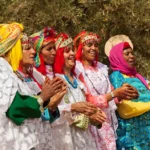Venezuela, a land of striking landscapes and vibrant traditions, expresses its cultural diversity through traditional clothing that blends indigenous, European, and African influences.
From the colorful attire of the plains to the ceremonial garments of indigenous groups, Venezuelan clothing embodies the country’s rich heritage and unique identity.
Cultural and Historical Foundations of Venezuelan Attire
The traditional clothing of Venezuela is deeply rooted in its history, shaped by the convergence of indigenous traditions and Spanish colonial influences. Over time, African cultural elements were also woven into the fabric of Venezuelan attire, resulting in a distinctive and colorful style.
Key Influences on Venezuelan Traditional Clothing
- 🇳🇪 Indigenous Heritage: Native tribes, such as the Wayúu and Warao, have preserved their traditional clothing styles, using natural materials and designs inspired by their environment.
- 🇪🇸 Spanish Colonial Legacy: European fabrics, embroidery, and tailoring techniques were introduced during colonization.
- 🇰🇪 African Contributions: The African diaspora brought vibrant patterns and dynamic styles, enriching Venezuelan clothing traditions.
Iconic Venezuelan Traditional Garments
Men’s Attire
- 👕 Liqui-liqui: A formal suit typically worn by men in the plains, consisting of a long-sleeved shirt and trousers made from linen or cotton. It’s recognized for its high neck and buttoned design.
- 👖 Ponchos: Woolen or cotton ponchos are common in cooler regions, offering both practicality and style.
- 🎮 Hats: Wide-brimmed straw hats are essential for protection from the sun, especially in agricultural areas.
Women’s Attire
- 🌟 Flowing Skirts: Brightly colored skirts with floral or geometric patterns are a hallmark of women’s traditional clothing.
- 🧳 Blouses: Embroidered or lace-adorned blouses add elegance and cultural charm.
- 💟 Shawls and Scarves: Often worn for both style and warmth.
- 🎩 Accessories: Jewelry, such as necklaces and bracelets, often features beads, shells, and natural materials.
Indigenous Attire
- 🌲 Wayúu Garments: The Wayúu people, indigenous to the Guajira Peninsula, wear long, flowing dresses known as mantas, often made of lightweight fabric with vibrant designs.
- 🔢 Warao Clothing: Warao communities, located in the Orinoco Delta, use natural fibers like palm leaves to craft skirts and headdresses.
Regional Variations in Venezuelan Clothing
Llanos (Plains)
The liqui-liqui is the most iconic garment in the Llanos region. Women’s attire includes colorful dresses, often worn during traditional dances like the joropo.
See also Exploring the Elegance of Traditional Moroccan Clothing: A Fusion of Heritage and Artistry
Exploring the Elegance of Traditional Moroccan Clothing: A Fusion of Heritage and Artistry
Andes Mountains
Cooler climates influence the use of woolen garments and layered clothing. Ponchos and shawls are common, paired with sturdy footwear.
Coastal Areas
The coastal regions favor light, breathable fabrics. Women wear dresses with tropical prints, and men often opt for loose shirts.
Amazon Region
Indigenous communities in the Amazon region create attire using natural materials like bark, fibers, and feathers, reflecting their deep connection to nature.
Traditional Clothing in Celebrations and Festivities
National Festivals
During events like Fiestas de San Juan and Carnival, traditional clothing is celebrated through vibrant costumes, elaborate headpieces, and lively dances.
See also Traditional Clothing of Colombia: A Vibrant Tapestry of Heritage and Diversity
Traditional Clothing of Colombia: A Vibrant Tapestry of Heritage and Diversity
Wedding Attire
Venezuelan weddings often feature traditional elements, with brides incorporating lace and embroidery into their gowns and grooms wearing liqui-liqui suits.
Dance Performances
Traditional dances, such as the joropo and tambor, showcase Venezuela’s colorful attire, with flowing skirts and embroidered blouses for women, and formal liqui-liqui suits for men.
Craftsmanship and Materials
Textiles
Venezuelan traditional clothing utilizes materials like cotton, linen, and wool. Indigenous communities also use natural fibers and dyes from plants and animals.
Weaving Techniques
Artisans employ traditional weaving methods to create intricate patterns, especially in accessories like belts and shawls.
Embroidery and Decoration
Intricate embroidery, lacework, and beadwork adorn many traditional garments, showcasing the skill and artistry of Venezuelan craftsmen.
Preservation and Modern Adaptations
Cultural Initiatives
Organizations and festivals promote the preservation of traditional clothing, ensuring these cultural treasures are not forgotten.
Fashion Industry
Contemporary designers are reimagining traditional Venezuelan clothing, blending modern aesthetics with traditional elements to appeal to new audiences.
A Celebration of Venezuelan Identity
Venezuelan traditional clothing is more than just fabric and thread; it’s a reflection of the country’s soul, a tapestry of its indigenous roots, colonial history, and vibrant culture. Through festivals, everyday wear, and modern interpretations, these garments continue to tell the story of Venezuela’s rich heritage and timeless beauty.